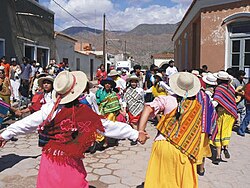History
| | This section needs expansion. You can help by adding to it. (January 2014) |
Peruvian music reflects the country’s rich cultural heritage, blending Indigenous, Spanish, and African influences. Pre-Columbian traditions, characterized by instruments like pan flutes and drums, were later infused with Spanish stringed instruments such as the guitar and harp. During the colonial period, African rhythms introduced vibrant percussive styles. Iconic genres like huayno and marinera emerged, highlighting regional diversity. In the 20th century, Peruvian music evolved further with criollo music gaining prominence and the rise of Andean fusion bands, like Los Kjarkas and international stars, such as Susana Baca, promoting Peru's musical identity globally.

The earliest printed polyphonic music in Peru, indeed anywhere in the Americas, was "Hanacpachap cussicuinin," composed or collected by Juan Pérez Bocanegra and printed in 1631. [1]


